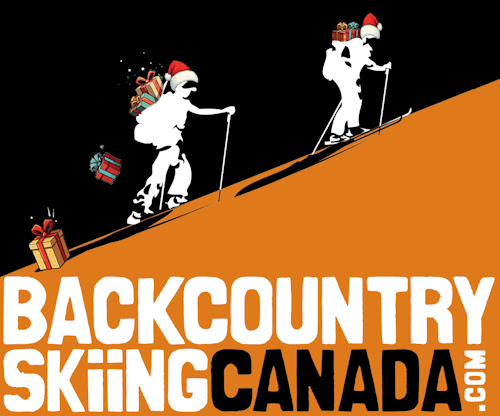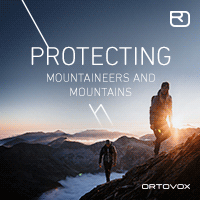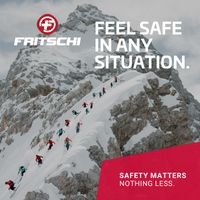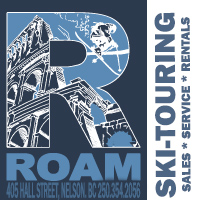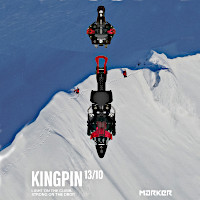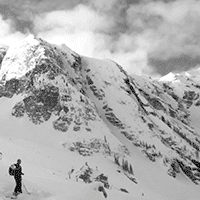Multiple Burial Searches - how to?
Having Problems in Multiple Burial Searches? Signal Overlap Explained.
by Backcountry Access on Friday, May 13, 2011 at 5:00am
Does your beacon not work like it’s advertised? Do you have trouble in multiple burial practices and don’t know why? This blog is going to attempt to explain why you may encounter these issues.
Last week I was able to attend the Canadian Avalanche Association’s annual general meeting. This five-day event takes place annually in Penticton, BC. Attendees include Canada’s top guides–both mechanized and ski touring–Canada’s top avalanche educators, and several prominent Canadian snow scientists. It’s the real deal, like a smaller version of the International Snow Science Workshop, but sponsored by Kokanee beer. The purpose is to share ideas, continuing research, and re-cap the season as a whole. And it’s all about avalanche safety.
After reading an article a few weeks back written by Canadian Mountain Holidays (CMH) guide Rob Whelan that appeared in the Avalanche.ca Journal, entitled “Today’s Transceivers: user expectations, performance limitations and marketing messages,” I was excited to see that Rob was on the agenda to speak at the meeting. Rob’s been a helicopter ski guide and avalanche educator for 21 years and is well respected when it comes to beacon knowledge and training.
Several points that Rob raised in his introduction were these:
1. Why do people still struggle with avalanche beacons?
2. Most modern users own a newer beacon and have several modern electronic devices. Why do they struggle?
3. Some teachers have a difficult time keeping up with technology.
Rob then went on to discuss how easy digital beacons are to use compared to the old days when the only choice was analog beacons. Digital beacons have made it easy to teach anyone how to do beacon searches, but one of the main concerns in the Canadian guiding community is a single searcher solving a multiple burial, a scenario that is more likely to occur in a guided than a recreational setting. In multiple burials, all beacons have their limitations and this is where Rob pointed out a major issue in multiple burial searching: signal overlap.
This past winter there was a report from a CAA Operations Level One avalanche course that had concerns about several students failing the beacon exam in which two beacons have to be found in five minutes or less. This sounded slightly odd since several of us at BCA have taken this course and are familiar with the exam procedure. Interestingly enough, the two transmitting beacons were Tracker2’s and the students who failed were using a “marking” function on their beacon to solve the multiple burial. It was believed by some that an incompatibility had been discovered between a marking beacon and the Tracker2 signals, but we know from our tests that the Tracker2 meets all the criteria for international beacon transmit standards. And we were certainly aware of signal overlap and the possibility of how it can affect the search mode of every beacon on the market. But we still tested this for countless hours, making 100 percent sure that we weren’t missing anything.
The result was quite productive and a first in the avalanche industry: after multiple field and laboratory tests by both sides, we issued a joint statement with the other beacon company explaining that there were no compatibility issues between the two beacons. The failure in the exam was more likely due to the students not understanding signal overlap and how to avoid it. Rob Whelan’s conclusion was similar when he stated “I suspect this was the issue we saw earlier in the winter.”
So what is signal overlap? Signal overlap is simply two or more beacon pulses (or “signals”) overlapping at some point to where it creates the illusion that there is only one signal, or less signals than there actually are.
In the diagrams below, what you see are two signals overlapping one another in the top diagram. When there isn’t signal overlap the signals are separated, which you can see in the lower diagram:
Signal Overlap
Signal Seperation
An analogy I commonly use when teaching courses is this: imagine a car racing track where there are four lanes and four race cars. One race car is traveling at 55mph, one is traveling at 65mph, one is traveling at 75mph, and one is traveling at 85mph. At some points during the race, the cars are going to be lined up in a row next to each other on the track for a certain amount of time. This could happen once or many times, it simply depends on the duration of the race. Are you following me? The race is your beacon search, the cars are the transmitting beacons under the snow and their speed is the amount of signals they put out per minute, with varying brands of beacons (or race cars). Here’s a video of what signal overlap looks like in the BCA lab:
One of the questions Rob received during his talk was “how many transmitting beacons does it take to get really bad signal overlap?” His answer was “…generally when a fourth beacon is introduced to a scenario.” We at BCA could not agree more. Over the past few years, the fourth beacon has always been the one that’s caused problems among all beacon models and resulted in total meltdown of a multiple burial practice search in some scenarios. But the good news is that there are alternative search techniques available to get out of a meltdown and continue searching.
So what should a single searcher do if he or she encounters signal overlap? I’m going to break it down by beacon model in a few paragraphs, but let’s assume that the search is for four transmitters and your beacon is going to have some difficulties. First off, you need to know how your beacon is supposed to work in a multiple burial involving four or more transmitters without applying any special search techniques. If you don’t, go back to the owner’s manual and the practice field. Secondly, if you are not familiar with the special search techniques called “Micro Search Strip” or “Three Circle Method” go to the following links and read about them. But then you need to practice them:
A. Micro Search Strip Technique (scroll down at this link):
http://216.234.170.191/newslet.....c_2006.htm
I’ll summarize it for you: in a multiple burial search, narrow the “search strip” in your signal search (also called primary search) to 20m or less (instead of the usual 40m). If the beacons are suspected to be in close proximity to each other, you should reduce it even further. The sky is the limit on the width of your path when you apply this technique since it’s related to the scenario. We commonly see professionals improvising the size of their micro strips. Imagine three buried transmitters in a 5m radius. You will likely be on your knees sweeping your beacon on the snow surface, methodically looking for different signals.
B. Three Circle Method:
http://backcountryaccess.com/i.....Method.pdf.
I’ll summarize this one also: after you find your first beacon, back off three meters and walk a circle around it with a three-meter radius, letting your beacon find other signals. Repeat two more circles if necessary, three meters off of each other. Imagine the middle three circles on a target and the first beacon you found is in the bullseye.
What do these two techniques have in common? GETTING AWAY FROM THE FIRST SIGNAL YOU FOUND. We feel that it’s important to have a quiver of multiple search techniques, regardless of what beacon model you have. So for me, this is what I use: T2 in regular search mode, which always finds the strongest signal. It has a multiple burial light to let me know if there are other beacons in the scenario—and it flashes if they are in close proximity to each other (ie more than one within five meters of the searcher). I’ll use SP mode to get a picture of the scenario, if necessary, although I often have a general idea of where the other victim is. I’ll use the Micro Search Strip or Three Circle Method when it’s greater than three transmitting units especially if I suspect some of them are close together.
So now that you know what your beacon is “supposed” to do in a multiple burial search and you’re familiar with two alternative multiple burial search techniques, you have a quiver of applications to apply to your beacon. Here’s what you do when that beacon doesn’t work like it’s supposed to–or as Rob Whelan noted in his talk, when the marketing messages fail:
1. Tracker DTS and Tracker2: SP mode. This helps you see other beacons in the scenario. It’s easy to use for finding up to four transmitters, but takes practice and can be tricky. The multiple burial light on the T2 can help identify when there is more than one signal in the general search area and more than one in close proximity. At that point, apply Micro Search Strips or the Three Circle Method to find other beacons if not confident using SP mode.
2. Barryvox Pulse: Marking. When the marking doesn’t work it’s important to know how to go into analog mode and reduce the signal sensitivity (volume) down to about five meters. It’s also important for the searcher to know how to search in analog mode. At this point you can use Micro Search Strips or Three Circle Method. If you insist on using marking, you may get a “stop” message in your display. In some cases the beacon will correct itself after you have stopped and stood still. In others it will not.
3. Barryvox Opto 3000: Multiple burial indicator light. Optional analog mode for multiple burials requires searcher being comfortable with analog searching and using Micro Search Strips or Three Circle Method.
4. Ortovox S1: Marking. Can display up to three buried victims on the screen. When the marking doesn’t work it’s important to know how to go into analog mode and reduce the signal sensitivity (volume) down to about five meters. It’s also important for the searcher to know how to search in analog mode. At this point you can use Micro Search Strips or Three Circle Method. If you insist on using marking, you may get a “stop” message. In some cases the beacon will correct itself after you have stopped and remained still. In others it will not.
5. Ortovox 3+: Marking. Multiple burial indicator for up to three signals. When marking doesn’t work it’s important to search methodically and try Micro Search Strips or Three Circle Method. Ortovox also advises a method called “sector” searching which is kind of like attacking the scenario from different quadrants.
6. Ortovox F1/M2: Strictly analog. User should be comfortable with Micro Search Strips or Three Circle Method with the sensitivity set down to five meters.
7. Pieps DSP: Marking. Multiple burial indicator for up to three signals. When marking doesn’t work it’s important to search methodically and try Micro Search Strips or Three Circle Method.
8. Pieps Freeride: Analog. User should be comfortable with Micro Search Strips or Three Circle Method.
There’s no harm in mastering multiple beacon searches as long as the searcher has first mastered single searches with his or her beacon. Guides are often well practiced at multiple burial searching but may need to better understand how their modern beacons work and the signal overlap nuances they may encounter. If a guide is leading a real multiple burial search, the clients will take orders from the guide. Those orders may include helping search with a beacon or getting probes and shovels ready.
For recreationists, the way to keep multiple burials more simple and effective is to apply more than one searcher if possible (also called “searching in parallel,” see http://www.backcountryaccess.c.....rallel.pdf ). The more searchers there are, the less of a problem signal overlap will be, since the searchers are spread out on the search area and have different signal strengths. In a best-case scenario, a recreational group involved in a multiple burial will have a designated leader who can take charge similar to a guide. This means the leader should have the confidence to give orders and be able to determine where to use extra manpower in the tasks where it’s needed the most.
But the truth is that almost all real multiple burial avalanches kill when there’s more than one completely buried victim. To see how the numbers stack up in reported incidents, take a look at the accident databases of http://www.avalanche.org/ and http://www.avalanche.ca/cac/.
The reality? Stick with basic avalanche protocol to avoid multiple burials: don’t expose more than one person at a time on a slope and get those route finding and terrain choice skills wired. If you make a mistake and do end up with a multiple burial, it then becomes all about group dynamics and excavation: leadership, communication, strategic shoveling and available manpower are the factors that determine the outcome in a real multiple burial. The beacon searching is the easy part.
